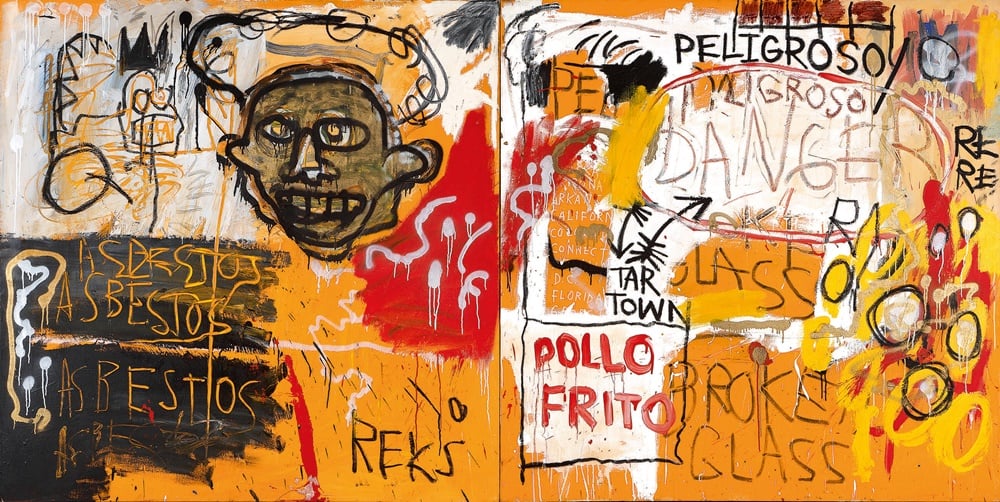
In 1982, Fay Gold, of Atlanta, Georgia, was a young art dealer with a very nice husband. She had a birthday coming up and he had given her a check for $5,000 to buy a diamond tennis bracelet that she had spotted on a recent trip to New York. When Gold was back in Manhattan she had every intention of acquiring it—but, fortunately, she also had an eye for other beautiful things.
Gold found herself in SoHo at the Annina Nosei Gallery at a fortuitous moment. Jean-Michel Basquiat had recently opened his first solo show at the gallery. Though the rest is history, little did Gold know that she too would be making history. While touring the gallery she came upon Basquiat’s Untitled (Pollo Frito), a major canvas that measured five feet by ten feet. The diptych had it all, as far as Basquiat is concerned, including a king’s crown, a crown of thorns, repetitive words, and an expressionistic head. The composition was held together by the artist’s fluid paint-handling, riotous color, and uncanny sense of placement of imagery.
Any thoughts of buying the diamond bracelet flew out the window. Gold found herself instead writing a check to Nosei for $5,200.
Twenty years later, she decided to part with the painting and sold it for around $1 million. “My husband thought I was a genius!” she told me. Now, on November 14, Sotheby’s will be selling Untitled (Pollo Frito)—the title translates to “Fried Chicken”—with an unpublished estimate of $25 million. (Times change!)
Jean-Michel Basquiat, Flexible (1984). Photo courtesy of Phillips.
In my opinion, the painting’s pre-sale estimate is a bargain compared to the $45.3 million that Basquiat’s Flexible brought at Phillips this past May. Flexible is an outstanding painting, but Untitled (Pollo Frito), with its seamless integration of painterly color, compelling imagery, and provocative language, creates an emotional frisson that the isolated figure in Flexible doesn’t quite achieve.
Untitled (Pollo Frito) was painted two years earlier, in 1982, when Basquiat was less concerned with his place in the art world’s pecking order. The painting crackles with the raw energy of New York’s East Village before it became infested with prosperous storefront art galleries. Basquiat painted from the heart, with a sense of abandon and exhilaration that would desert him only two years later, when he began showing at the image-conscious Mary Boone Gallery.
In 1985, three years after buying the canvas, Gold went to Basquiat’s Great Jones Street studio (which he rented from Andy Warhol for $4,000 a month) and approached him about doing a show at her gallery. According to Phoebe Hoban’s book Basquiat: A Quick Killing in Art, he sold her a group of eleven drawings for $16,500. In the early 1990s, Gold confirmed the story while talking to me at the San Francisco Art Fair. During the run of the fair, she wound up selling a single drawing to Martin Muller, the connoisseur and proprietor of the gallery Modernism Inc., for almost that amount alone.
Fay Gold, courtesy of Fay Gold Gallery.
But back to Gold’s studio visit with Basquiat: “While I was selecting drawings, a large Maine Coon cat named Rasputin rubbed up against me. I guess Jean-Michel noticed that the cat took a liking to me because two months after his opening at my gallery, he put the cat on a plane and sent him to me as a gift! He said he couldn’t take care of it anymore.”
Fay continued, “I wound up renaming the cat Basquiat.”
Naturally, I was charmed by the story. But I also kept thinking: Can you imagine what it must have been like being Basquiat’s cat?
Richard Polsky owns Richard Polsky Art Authentication, which specializes in authenticating the work of Andy Warhol, Keith Haring, and Jean-Michel Basquiat.